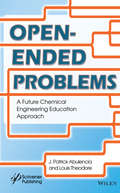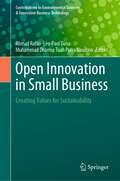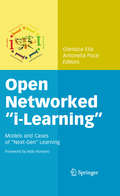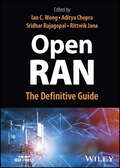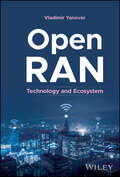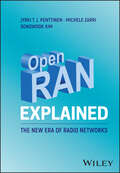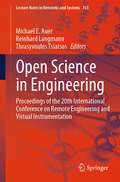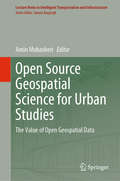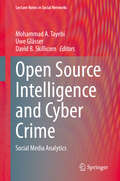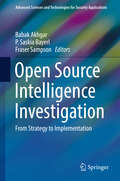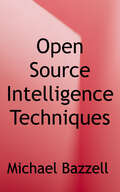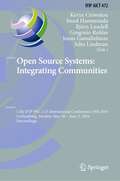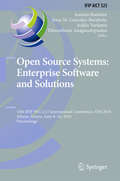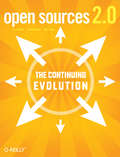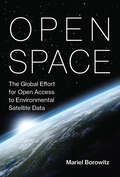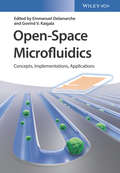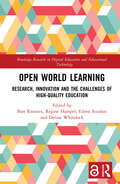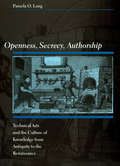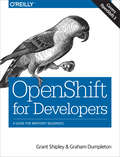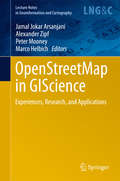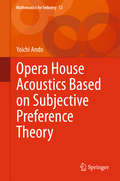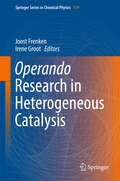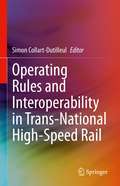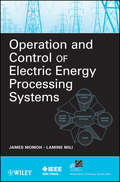- Table View
- List View
Open-Ended Problems: A Future Chemical Engineering Education Approach
by Louis Theodore J. Patrick AbulenciaThis is a unique book with nearly 1000 problems and 50 case studies on open-ended problems in every key topic in chemical engineering that helps to better prepare chemical engineers for the future. The term "open-ended problem" basically describes an approach to the solution of a problem and/or situation for which there is not a unique solution. The Introduction to the general subject of open-ended problems is followed by 22 chapters, each of which addresses a traditional chemical engineering or chemical engineering-related topic. Each of these chapters contain a brief overview of the subject matter of concern, e.g., thermodynamics, which is followed by sample open-ended problems that have been solved (by the authors) employing one of the many possible approaches to the solutions. This is then followed by approximately 40-45 open-ended problems with no solutions (although many of the authors' solutions are available for those who adopt the book for classroom or training purposes). A reference section is included with the chapter's contents. Term projects, comprised of 12 additional chapter topics, complement the presentation. This book provides academic, industrial, and research personnel with the material that covers the principles and applications of open-ended chemical engineering problems in a thorough and clear manner. Upon completion of the text, the reader should have acquired not only a working knowledge of the principles of chemical engineering, but also (and more importantly) experience in solving open-ended problems. What many educators have learned is that the applications and implications of open-ended problems are not only changing professions, but also are moving so fast that many have not yet grasped their tremendous impact. The book drives home that the open-ended approach will revolutionize the way chemical engineers will need to operate in the future.
Open Innovation in Small Business: Creating Values for Sustainability (Contributions to Environmental Sciences & Innovative Business Technology)
by Ahmad Rafiki Léo-Paul Dana Muhammad Dharma Tuah Putra NasutionThe book emphasizes the open innovation which mainly consists of innovation inside-out and outside-in needed by the small and medium-sized enterprises (SME). This open innovation relates to the performance and survival of SMEs in a global competition. The SMEs must learn, have, and do innovative initiatives and actions. This book elaborates all related concepts and innovative practices toward better performances, which includes the impacts of globalization and dynamic markets with a special focus on sustainability. Every country has different perspectives considering open innovation as a solution to the businesses. Thus, readers can see the best practices to be adopted or adapted in their business environment. The book includes the solution for the SMEs in terms of creating values. Open innovation is known as a window for creating values. Open innovation can be seen by SMEs as a possible way to adapt and thrive in an increasingly competitive and volatile environment, including to overcome their limitations. By implementing open innovation, SMEs will compensate for their lack of internal resources and competencies through external resources to develop new technologies and take advantage of market opportunities. This book is dedicated to the entrepreneurs, businessmen, practitioners, policymakers, academician, and students in developing strategies and having future plan related to innovation which is crucial for creating values in business operations. A benchmarking through innovation is important to improve among businesses to achieve effectiveness and efficiency.
Open Networked "i-Learning"
by Antonella Poce Gianluca EliaOpen Source Applications Springer Book Series Editor: Ernesto Damiani, University of Milan, Italy http://sesar.dti.unimi.it/ossbook/ A new overall interdisciplinary framework called "i learning" integrates managerial organization and technology aspects also known as "technology enhanced learning". Open Networked "i Learning": Models and Cases of "Next-Gen" Learning begins its investigation with the important changes that have recently occurred within the management, technology and society fields. Social and cultural aspects of society that influence the "dynamics" and the "styles" of the learning processes are presented as well. The last section of this edited volume focuses on possible future scenarios of the learning processes by describing the main models, processes, tools, technologies, and involved organizations. Open Networked "i Learning": Models and Cases of "Next-Gen" Learning is suitable for advanced under- and graduate level students and professors concentrating on computer science, engineering and business management as a secondary text or reference book. Professionals and researchers who work in the related industry of technology enhanced learning will find this book useful as well.
Open RAN: The Definitive Guide
by Ian C. Wong Aditya Chopra Sridhar Rajagopal Rittwik JanaOpen RAN A comprehensive survey of Open RAN technology and its ecosystem In Open RAN: The Definitive Guide, a team of distinguished industry leaders deliver an authoritative guide to all four principles of the Open RAN vision: openness, virtualization, intelligence, and interoperability. Written by the industry experts currently defining the specifications, building the systems, and testing and deploying the networks, the book covers O-RAN architecture, the fronthaul interface, security, cloudification, virtualization, intelligence, certification, badging, and standardization. This critical reference on Open RAN explains how and why an open and disaggregated, intelligent, and fully virtualized network is the way networks should be designed and deployed moving forward. Readers will also find: A thorough introduction from key industry players, including AT&T, Telefonica, Mavenir, VMWare, Google and VIAVI Comprehensive explorations of Open X-Haul transport networks and other unique 5G capabilities Practical discussions of the four pillars of O-RAN architecture: openness, virtualization, intelligence, and interoperability Comprehensive treatments of how smaller vendors can introduce their own services and customize the network Perfect for engineers, product managers, and marketing professionals in the telecom industry, Open RAN: The Definitive Guide will also benefit graduate students, researchers, and engineers in government agencies with involvement in the wireless and telecom industries.
Open RAN: Technology and Ecosystem
by Vladimir YanoverComplete guide to identifying and describing basic Open RAN technology concepts and understanding the structure and dynamics of the ecosystem Open RAN describes key aspects and provides insight into the structure and dynamics of the Open RAN ecosystem, linking the key technology aspects to the market drivers and showing the role of technology in the ecosystem's progress. This book explores Open RAN cloudification techniques and deployment scenarios down to details of the RAN split options and use of hardware accelerators. Open RAN programmability for non-real-time operations (SMO, Non-RT RIC, A1) and real-time operations (Near-RT RIC, E2) are discussed alongside essentials of RAN control, network data collection, notifications of events, policy control, and network and service management. Examples of implementation by leading vendors and open-source communities are provided throughout to show the potential of the Open RAN ecosystem and technology. Written by an industry insider and a key contributor to the development of the technology, this book includes: Activities and structure of the O-RAN Alliance, including work groups, committees, and the O-RAN Software Community (OSC) Evolution of the Open RAN ecosystem, covering O-RAN specifications releases and compliant products, ongoing and planned developments, as well as ongoing and planned trials and commercial deployments SMO and Non-RT RIC functional procedures, A1 policy-based interface, rApps Near-RT RIC functional procedures, covering subscription, notifications, control, policy, and query procedures; E2 services, covering REPORT, INSERT, CONTROL, and POLICY services; Near-RT RIC as an xApps hosting platform Traffic steering, QoS optimization, NSSI resource optimization, and massive MIMO optimization, covering outer and inner control loops, network data collection, and optimization actions With a combined overview of key technology aspects and practical examples, Open RAN is a practical and highly useful reference for researchers, engineers, and marketing experts employed by mobile carriers, equipment vendors, government bodies, and universities, as well as professionals in associated communications fields and PhD electrical engineering students.
Open RAN Explained: The New Era of Radio Networks
by Jyrki T. Penttinen Michele Zarri Dongwook KimOpen RAN EXPLAINED A pioneering outline of the concepts that enhance 5G capabilities to revolutionize the telecommunications industry. Open radio-access network, or Open RAN, is a type of network architecture in which baseband and radio unit components from different suppliers can operate seamlessly in concert. Advances in network communication were, until recently, hampered by the proprietary network operations of each mobile operator; the advent of 5G, however, with its service-based architecture model, has finally opened the door to the expansion of connectivity on the Open RAN model. This transformation promises to define the future of mobile network architecture. Open RAN Explained is among the first books dedicated to this groundbreaking technology. Its comprehensive but accessible summary of current and future developments in Open RAN promises to facilitate network deployment and device design, as well as to provide a handy reference for network professionals in a range of different fields. The result is a must-read volume for anyone looking to understand the future of wireless communication. Open RAN Explained readers will also find: In-depth description of the challenges and opportunities of network modularizationAnalysis conversant with the latest release specifications of the O-RAN Allliance, GSMA OP/TIP, and other key emerging technologiesAuthors working at the leading edge of 5G network communications Open RAN Explained is ideal for network operators, network element and device manufacturers, telecommunications researchers, and advanced students, as well as industry-adjacent figures such as regulators, consultants, and marketing professionals.
Open Science in Engineering: Proceedings of the 20th International Conference on Remote Engineering and Virtual Instrumentation (Lecture Notes in Networks and Systems #763)
by Michael E. Auer Reinhard Langmann Thrasyvoulos TsiatsosThe REV Conference is the annual conference of the International Association of Online Engineering (IAOE) together with the Global Online Laboratory Consortium (GOLC).REV 2023 is the 20th in a series of annual events concerning the area of online engineering, cyber-physical systems and Internet of things, including remote engineering and virtual instrumentation.In a globally connected world, the interest in online collaboration, teleworking, remote services, and other digital working environments is rapidly increasing. In response to that, the general objective of this conference is to contribute and discuss fundamentals, applications, and experiences in the field of online and remote engineering, virtual instrumentation, and other related new technologies, including:Cross-realityOpen ScienceInternet of Things and Industrial Internet of ThingsIndustry 4.0Cyber-securityM2M and smart objects.
Open Source Geospatial Science for Urban Studies: The Value of Open Geospatial Data (Lecture Notes in Intelligent Transportation and Infrastructure)
by Amin MobasheriThis book is mainly focused on two themes: transportation and smart city applications. Open geospatial science and technology is an increasingly important paradigm that offers the opportunity to promote the democratization of geographical information, the transparency of governments and institutions, as well as social, economic and urban opportunities. During the past decade, developments in the area of open geospatial data have greatly increased. The open source GIS research community believes that combining free and open software, open data, as well as open standards, leads to the creation of a sustainable ecosystem for accelerating new discoveries to help solve global cross-disciplinary urban challenges. The vision of this book is to enrich the existing literature on this topic, and act one step towards more sustainable cities through employment of open source GIS solutions that are reproducible. Various contributions are provided and practically implemented in several urban use cases. Therefore, apart from researchers, lecturers and students in the geography/urbanism domain, crowdsourcing and VGI domain, as well as open source GIS domain, it is believed the specialists and mentors in municipalities and urban planning departments as well as professionals in private companies would be interested to read this book.
Open Source Intelligence and Cyber Crime: Social Media Analytics (Lecture Notes in Social Networks)
by Mohammad A. Tayebi Uwe Glässer David B. SkillicornThis book shows how open source intelligence can be a powerful tool for combating crime by linking local and global patterns to help understand how criminal activities are connected. Readers will encounter the latest advances in cutting-edge data mining, machine learning and predictive analytics combined with natural language processing and social network analysis to detect, disrupt, and neutralize cyber and physical threats. Chapters contain state-of-the-art social media analytics and open source intelligence research trends. This multidisciplinary volume will appeal to students, researchers, and professionals working in the fields of open source intelligence, cyber crime and social network analytics. Chapter Automated Text Analysis for Intelligence Purposes: A Psychological Operations Case Study is available open access under a Creative Commons Attribution 4.0 International License via link.springer.com.
Open Source Intelligence Investigation: From Strategy to Implementation (Advanced Sciences and Technologies for Security Applications)
by Babak Akhgar, P. Saskia Bayerl and Fraser SampsonOne of the most important aspects for a successful police operation is the ability for the police to obtain timely, reliable and actionable intelligence related to the investigation or incident at hand. Open Source Intelligence (OSINT) provides an invaluable avenue to access and collect such information in addition to traditional investigative techniques and information sources. This book offers an authoritative and accessible guide on how to conduct Open Source Intelligence investigations from data collection to analysis to the design and vetting of OSINT tools. In its pages the reader will find a comprehensive view into the newest methods for OSINT analytics and visualizations in combination with real-life case studies to showcase the application as well as the challenges of OSINT investigations across domains. Examples of OSINT range from information posted on social media as one of the most openly available means of accessing and gathering Open Source Intelligence to location data, OSINT obtained from the darkweb to combinations of OSINT with real-time analytical capabilities and closed sources. In addition it provides guidance on legal and ethical considerations making it relevant reading for practitioners as well as academics and students with a view to obtain thorough, first-hand knowledge from serving experts in the field.
Open Source Intelligence Techniques: Resources for Searching and Analyzing Online Information
by Michael BazzellNew (2022) 9th Edition contains many updated techniques, scripts, and tools! It is time to look at OSINT in a different way. For many years, and within previous editions of this book, we have relied on external resources to supply our search tools, virtual environments, and investigation techniques. We have seen this protocol fail us when services shut down, websites disappear, and custom resources are dismantled due to outside pressures. <p><p>This book aims to correct our dilemma. We will take control of our investigative resources and become self-reliant. There will be no more need for online search tools; we will make and host our own locally. We will no longer seek pre-built virtual machines; we will create and configure our own. This book puts the power back in your hands. <p><p>The new OSINT professional must be self-sustaining and possess their own tools and resources. You will become a more proficient subject matter expert who will be armed with the knowledge and readiness to articulate the sources of your findings. <p><p>This new ninth edition contains hundreds of pages which have been updated to keep your OSINT investigative methods fresh. It includes new online and offline search tools; a new Linux OSINT virtual machine with pre-built scripts; and tutorials to replicate all Linux OSINT tools within Mac and Windows operating systems. Brand-new search methods for Facebook, Instagram, LinkedIn, YouTube, and others ensure you have the latest techniques within your online investigation arsenal. An entire section is devoted to Methodology, Workflow, Documentation, and Ethics which provides a clear game plan for your next active investigation.
Open Source Systems: 12th IFIP WG 2.13 International Conference, OSS 2016, Gothenburg, Sweden, May 30 - June 2, 2016, Proceedings (IFIP Advances in Information and Communication Technology #472)
by Kevin Crowston Imed Hammouda Björn Lundell Gregorio Robles Jonas Gamalielsson Juho LindmanThis book constitutes the refereed proceedings of the 12th International IFIP WG 2.13 International Conference on Open Source Systems, OSS 2016, held in Gothenburg, Sweden, in May/June 2016. The 13 revised full papers presented were carefully reviewed and selected from 38 submissions. The papers cover a wide range of topics related to free, libre, and open source software, including: organizational aspects of communities; organizational adoption; participation of women; software maintenance and evolution; open standards and open data; collaboration; hybrid communities; code reviews; and certification.
Open Source Systems: 14th IFIP WG 2.13 International Conference, OSS 2018, Athens, Greece, June 8-10, 2018, Proceedings (IFIP Advances in Information and Communication Technology #525)
by Ioannis Stamelos Jesus M. Gonzalez-Barahoña Iraklis Varlamis Dimosthenis AnagnostopoulosThis book constitutes the refereed proceedings of the 14th IFIP WG 2.13 International Conference on Open Source Systems, OSS 2018, held in Athens, Greece, in June 2018.The 14 revised full papers and 2 short papers presented were carefully reviewed and selected from 38 submissions. The papers cover a wide range of topics in the field of free/libre open source software (FLOSS) and are organized in the following thematic sections: organizational aspects of OSS projects, OSS projects validity, mining OSS data, OSS in public administration, OSS governance, and OSS reusability.
Open Sources 2.0: The Continuing Evolution
by Chris DiBona Mark Stone Danese CooperOpen Sources 2.0 is a collection of insightful and thought-provoking essays from today's technology leaders that continues painting the evolutionary picture that developed in the 1999 book Open Sources: Voices from the Revolution .These essays explore open source's impact on the software industry and reveal how open source concepts are infiltrating other areas of commerce and society. The essays appeal to a broad audience: the software developer will find thoughtful reflections on practices and methodology from leading open source developers like Jeremy Allison and Ben Laurie, while the business executive will find analyses of business strategies from the likes of Sleepycat co-founder and CEO Michael Olson and Open Source Business Conference founder Matt Asay.From China, Europe, India, and Brazil we get essays that describe the developing world's efforts to join the technology forefront and use open source to take control of its high tech destiny. For anyone with a strong interest in technology trends, these essays are a must-read.The enduring significance of open source goes well beyond high technology, however. At the heart of the new paradigm is network-enabled distributed collaboration: the growing impact of this model on all forms of online collaboration is fundamentally challenging our modern notion of community.What does the future hold? Veteran open source commentators Tim O'Reilly and Doc Searls offer their perspectives, as do leading open source scholars Steven Weber and Sonali Shah. Andrew Hessel traces the migration of open source ideas from computer technology to biotechnology, and Wikipedia co-founder Larry Sanger and Slashdot co-founder Jeff Bates provide frontline views of functioning, flourishing online collaborative communities.The power of collaboration, enabled by the internet and open source software, is changing the world in ways we can only begin to imagine.Open Sources 2.0 further develops the evolutionary picture that emerged in the original Open Sources and expounds on the transformative open source philosophy."This is a wonderful collection of thoughts and examples bygreat minds from the free software movement, and is a must have foranyone who follows free software development and project histories."--Robin Monks, Free Software MagazineThe list of contributors includeAlolita SharmaAndrew HesselBen LaurieBoon-Lock YeoBruno SouzaChris DiBonaDanese CooperDoc SearlsEugene KimGregorio RoblesIan MurdockJeff BatesJeremy AllisonJesus M. Gonzalez-BarahonaKim PoleseLarry SangerLouisa LiuMark StoneMark StoneMatthew N. AsayMichael OlsonMitchell BakerPamela JonesRobert AdkinsRuss NelsonSonali K. ShahStephen R. WalliSteven WeberSunil SaxenaTim O'ReillyWendy Seltzer
Open Space: The Global Effort for Open Access to Environmental Satellite Data (Information Policy)
by Mariel BorowitzAn examination of environmental satellite data sharing policies, offering a model of data-sharing policy development, case and practical recommendations for increasing global data sharing.Key to understanding and addressing climate change is continuous and precise monitoring of environmental conditions. Satellites play an important role in collecting climate data, offering comprehensive global coverage that can't be matched by in situ observation. And yet, as Mariel Borowitz shows in this book, much satellite data is not freely available but restricted; this remains true despite the data-sharing advocacy of international organizations and a global open data movement. Borowitz examines policies governing the sharing of environmental satellite data, offering a model of data-sharing policy development and applying it in case studies from the United States, Europe, and Japan—countries responsible for nearly half of the unclassified government Earth observation satellites. Borowitz develops a model that centers on the government agency as the primary actor while taking into account the roles of such outside actors as other government officials and non-governmental actors, as well as the economic, security, and normative attributes of the data itself. The case studies include the U.S. National Aeronautics and Space Administration (NASA) and the U.S. National Oceanographic and Atmospheric Association (NOAA), and the United States Geological Survey (USGS); the European Space Agency (ESA) and the European Organization for the Exploitation of Meteorological Satellites (EUMETSAT); and the Japanese Aerospace Exploration Agency (JAXA) and the Japanese Meteorological Agency (JMA). Finally, she considers the policy implications of her findings for the future and provides recommendations on how to increase global sharing of satellite data.
Open-Space Microfluidics: Concepts, Implementations, Applications
by Emmanuel Delamarche Govind V. KaigalaSummarizing the latest trends and the current state of this research field, this up-to-date book discusses in detail techniques to perform localized alterations on surfaces with great flexibility, including microfluidic probes, multifunctional nanopipettes and various surface patterning techniques, such as dip pen nanolithography. These techniques are also put in perspective in terms of applications and how they can be transformative of numerous (bio)chemical processes involving surfaces. The editors are from IBM Zurich, the pioneers and pacesetters in the field at the forefront of research in this new and rapidly expanding area.
Open Standards and the Digital Age
by Andrew L. RussellHow did openness become a foundational value for the networks of the twenty-first century? Open Standards and the Digital Age answers this question through an interdisciplinary history of information networks that pays close attention to the politics of standardization. For much of the twentieth century, information networks such as the monopoly Bell System and the American military's Arpanet were closed systems subject to centralized control. In the 1970s and 1980s, however, engineers in the United States and Europe experimented with design strategies to create new digital networks. In the process, they embraced discourses of "openness" to describe their ideological commitments to entrepreneurship, technological innovation, and participatory democracy. The rhetoric of openness has flourished - for example, in movements for open government, open source software, and open access publishing - but such rhetoric also obscures the ways the Internet and other "open" systems still depend heavily on hierarchical forms of control.
Open World Learning: Research, Innovation and the Challenges of High-Quality Education (Routledge Research in Digital Education and Educational Technology)
by Bart Rienties Regine Hampel Eileen Scanlon Denise WhitelockThis book provides state-of-the-art contemporary research insights into key applications and processes in open world learning. Open world learning seeks to understand access to education, structures, and the presence of dialogue and support systems. It explores how the application of open world and educational technologies can be used to create opportunities for open and high-quality education. Presenting ground-breaking research from an award winning Leverhulme doctoral training programme, the book provides several integrated and cohesive perspectives of the affordances and limitations of open world learning. The chapters feature a wide range of open world learning topics, ranging from theoretical and methodological discussions to empirical demonstrations of how open world learning can be effectively implemented, evaluated, and used to inform theory and practice. The book brings together a range of innovative uses of technology and practice in open world learning from 387,134 learners and educators learning and working in 136 unique learning contexts across the globe and considers the enablers and disablers of openness in learning, ethical and privacy implications, and how open world learning can be used to foster inclusive approaches to learning across educational sectors, disciplines and countries. The book is unique in exploring the complex, contradictory and multi-disciplinary nature of open world learning at an international level and will be of great interest to academics, researchers, professionals, and policy makers in the field of education technology, e-learning and digital education.
Openness, Secrecy, Authorship: Technical Arts and the Culture of Knowledge from Antiquity to the Renaissance
by Pamela O. LongA history of the book and intellectual property that includes military technology and military secrets.Winner of The Morris D. Forkosch Prize from the Journal of the History of IdeasIn today's world of intellectual property disputes, industrial espionage, and book signings by famous authors, one easily loses sight of the historical nature of the attribution and ownership of texts. In Openness, Secrecy, Authorship: Technical Arts and the Culture of Knowledge from Antiquity to the Renaissance, Pamela Long combines intellectual history with the history of science and technology to explore the culture of authorship. Using classical Greek as well as medieval and Renaissance European examples, Long traces the definitions, limitations, and traditions of intellectual and scientific creation and attribution. She examines these attitudes as they pertain to the technical and the practical. Although Long's study follows a chronological development, this is not merely a general work. Long is able to examine events and sources within their historical context and locale. By looking at Aristotelian ideas of Praxis, Techne, and Episteme. She explains the tension between craft and ideas, authors and producers. She discusses, with solid research and clear prose, the rise, wane, and resurgence of priority in the crediting and lionizing of authors. Long illuminates the creation and re-creation of ideas like "trade secrets," "plagiarism," "mechanical arts," and "scribal culture." Her historical study complicates prevailing assumptions while inviting a closer look at issues that define so much of our society and thought to this day. She argues that "a useful working definition of authorship permits a gradation of meaning between the poles of authority and originality," and guides us through the term's nuances with clarity rarely matched in a historical study.
OpenShift for Developers: A Guide for Impatient Beginners
by Graham Dumpleton Grant ShipleyKeen to build web applications for the cloud? Get a quick hands-on introduction to OpenShift, the open source Platform as a Service (PaaS) offering from Red Hat. With this practical guide, you’ll learn the steps necessary to build, deploy, and host a complete real-world application on OpenShift without having to slog through long, detailed explanations of the technologies involved. OpenShift enables you to use Docker application containers and the Kubernetes cluster manager to automate the way you create, ship, and run applications. Through the course of the book, you’ll learn how to use OpenShift and the Wildfly application server to build and then immediately deploy a Java application online. Learn about OpenShift’s core technology, including Docker-based containers and Kubernetes; Use a virtual machine with OpenShift installed and configured on your local environment; Create and deploy your first application on the OpenShift platform; Add language runtime dependencies and connect to a database; Trigger an automatic rebuild and redeployment when you push changes to the repository; Get a working environment up in minutes with application templates; Use commands to check and debug your application; Create and build Docker-based images for your application.
OpenStreetMap in GIScience
by Jamal Jokar Arsanjani Alexander Zipf Peter Mooney Marco HelbichThis edited volume presents a collection of lessons learned with, and research conducted on, OpenStreetMap, the goal being to promote the project's integration. The respective chapters address a) state-of-the-art and cutting-edge approaches to data quality analysis in OpenStreetMap, b) investigations on understanding OpenStreetMap contributors and the nature of their contributions, c) identifying patterns of contributions and contributors, d) applications of OpenStreetMap in different domains, e) mining value-added knowledge and information from OpenStreetMap, f) limitations in the analysis OpenStreetMap data, and g) integrating OpenStreetMap with commercial and non-commercial datasets. The book offers an ideal opportunity to present and disseminate a number of cutting-edge developments and applications in the field of geography, spatial statistics, GIS, social science, and cartography.
Opera House Acoustics Based on Subjective Preference Theory
by Yoichi AndoThis book focuses on opera house acoustics based on subjective preference theory; it targets researchers in acoustics and vision who are working in physics, psychology and brain physiology. This book helps readers to understand any subjective attributes in relation to objective parameters based on the powerful and workable model of the auditory system. It is reconfirmed here that the well-known Helmholtz theory, which was based on a peripheral model of the auditory system, may not well describe pitch, timbre and duration as well as the spatial sensations described in this book, nor overall responses such as subjective preference of sound fields and the annoyance of environmental noise.
Operando Research in Heterogeneous Catalysis
by Joost Frenken Irene GrootThis book is devoted to the emerging field of techniques for visualizing atomic-scale properties of active catalysts under actual working conditions, i. e. high gas pressures and high temperatures. It explains how to understand these observations in terms of the surface structures and dynamics and their detailed interplay with the gas phase. This provides an important new link between fundamental surface physics and chemistry, and applied catalysis. The book explains the motivation and the necessity of operando studies, and positions these with respect to the more traditional low-pressure investigations on the one hand and the reality of industrial catalysis on the other. The last decade has witnessed a rapid development of new experimental and theoretical tools for operando studies of heterogeneous catalysis. The book has a strong emphasis on the new techniques and illustrates how the challenges introduced by the harsh, operando conditions are faced for each of these new tools. Therefore, one can also read this book as a collection of recipes for the development of operando instruments. At present, the number of scientific results obtained under operando conditions is still limited and mostly focused on a simple test reaction, the catalytic oxidation of CO. This reaction thus forms a natural binding element between the chapters, linking the demonstrations of new techniques, and also connecting the theoretical and experimental studies. Some first results on other reactions are also presented. If there is one thing that can be concluded already in this early stage, it is that the catalytic conditions themselves can have dramatic effects on the structure and composition of the surfaces of catalysts, which, in turn can greatly affect the mechanisms, the activity, and the selectivity of the chemical reactions that they catalyze.
Operating Rules and Interoperability in Trans-National High-Speed Rail
by Simon Collart-DutilleulThis book examines the problem of interoperability related to operating rules and gives an overview of the formal method approaches related to this subject. The book examines the interoperability issues concerning implementation of European Rail Traffic Management System (ERTMS) while crossing a boarder. It also looks at the implementing of the ERTMS and provides solutions regarding operating rules for ERTMS lines, using formal methods and simulation tools. The contributors will also discuss operating rule validation and formal methods for safety assessment.
Operation and Control of Electric Energy Processing Systems: Standards In Practice (IEEE Press Series on Power Engineering #72)
by Marios C. Angelides Harry AgiusThe purpose of this book is to provide a working knowledge and an exposure to cutting edge developments in operation and control of electric energy processing systems. The book focuses on the modeling and control of interdependent communications and electric energy systems, Micro-Electro-Mechanical Systems (MEMS), and the interdisciplinary education component of the EPNES initiative.
